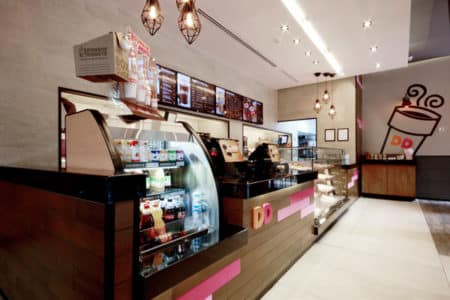
Heidi Cron has worn out her passport since joining Dunkin’ Brands in 2013. Her travel document has stamps from Brazil, Honduras, Guatemala, the United Kingdom, Iceland, Sweden, Switzerland, Poland, the United Arab Emirates, Bahrain, and Mexico.
As she travels, Cron visits new markets, sipping local coffee, observing competitors, and soliciting valuable feedback from prospective customers. As international store design lead, Cron works with native franchisees and architects to adapt and localize the brand’s international restaurant design prototype.
The famed coffee and baked-goods chain is active in 44 countries. Dunkin’ Donuts continues to grow its presence around the world in regions including Asia Pacific, Europe, the Middle East, and Latin America. The brand also recently announced that it will begin opening restaurants in South Africa, with an initial focus on the Cape Town and Johannesburg areas.
Whether enhancing a presence in an existing market or preparing to enter a new one, Cron and her teams design and implement brand-appropriate, culturally relevant elements that will fit into each local scene to attract and entice customers. Armed with intel from the brand’s internal consumer brand insights group, she hits the ground about five months before a new store opens to work alongside architects and franchisees. The process has been successful in Mexico, where Cron says she found a “dream team” that’s helping her export the brand’s concepts and designs to other locations worldwide.
When it comes to the success of the Mexico team, Cron says it’s a combination of experience, fit, and communication.
“We had an experienced franchisee who hired a great architect who had a deep knowledge of food service,” she says. “Everyone was willing to invest resources to work together and partner closely to execute the best design for each location.”
After Cron introduced Dunkin’ Donuts’ portfolio of designs, the team picked the concept they felt was most appropriate for the market. The team collaborated to localize design to Mexico in a way that would fit the market without compromising brand identity.

The process is an educational one. Dunkin’ offers its customers great coffee and food around the world. However, Cron and her team have to understand distinctions such as local flavor profiles, whether customers come to the restaurants alone or in groups, what time of day customers visit the restaurants, and whether they prefer to eat inside or take their food to go.
“I’m always surprised at the subtleties of culture, and I’m always reminded of how important it is for us to understand culture and respond accordingly,” Cron says.
When customers enter one of Dunkin’ Donuts’ Mexico City locations, they’ll step into a space that looks and feels more like a café and less like a traditional donut shop. The design team used lighting to create a variety of atmospheres while providing distinct seating zones, including lounge areas, community tables with electrical outlets, and bar seating along windows.
As Cron worked to roll out the initial international design prototypes, she had a realization: architects and partners around the world were rendering design standards in various ways. Some followed requirements and regulations exactly while others took a more liberal approach.
“If you compared two designs from different parts of the world side by side, you might not realize you were looking at something from the same brand,” Cron says.
To address the problem, she’s created a stronger set of design guidelines that allow individual partners to adhere to standards while understanding where deviation is possible. After testing several of these enhanced design elements in selected markets, Cron will solicit feedback and make adjustments before rolling out prototype enhancements to all international Dunkin’ Donuts licensees.
Cron is confident that her designs are making an impact, although she says there’s no exact metric by which she measures success.
“How can I prove that store design drives revenue?” she asks. “Driving franchisee profitability is always a top priority—and we strive to combine great design with our value proposition. I feel like we have succeeded when I walk into a restaurant and see happy customers.”


